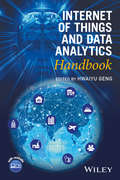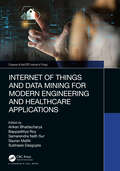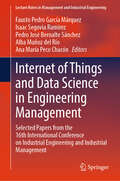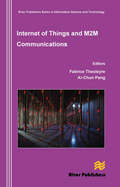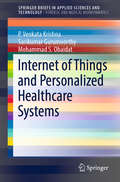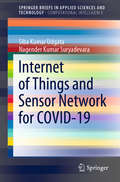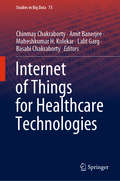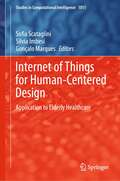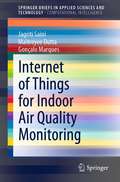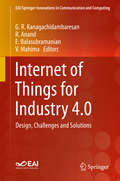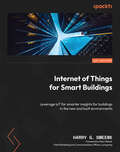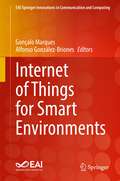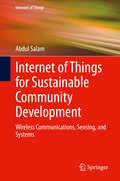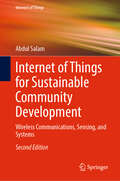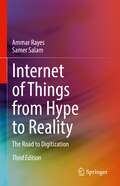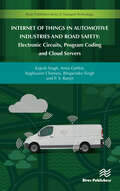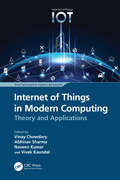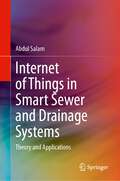- Table View
- List View
Internet of Things and Cyber Physical Systems: Security and Forensics (Advances in Cybersecurity Management)
by Yassine Maleh Akashdeep Bhardwaj Keshav Kaushik Susheela DahiyaThe quantity, diversity, and sophistication of Internet of Things (IoT) items are rapidly increasing, posing significant issues but also innovative solutions for forensic science. Such systems are becoming increasingly common in public locations, businesses, universities, residences, and other shared offices, producing enormous amounts of data at rapid speeds in a variety of forms. IoT devices can be used as suspects, digital witnesses, or instruments of crime and cyberattacks, posing new investigation problems, forensic issues, security threats, legal concerns, privacy concerns, and ethical dilemmas. A cyberattack on IoT devices might target the device itself or associated systems, particularly vital infrastructure. This book discusses the advancements in IoT and Cyber Physical Systems (CPS) forensics. The first objective is to learn and understand the fundamentals of IoT forensics. This objective will answer the question of why and how IoT has evolved as one of the most promising and widely accepted technologies across the globe and has many widely accepted applications. The second objective is to learn how to use CPS to address many computational problems. CPS forensics is a promising domain, and there are various advancements in this field. This book is structured so that the topics of discussion are relevant to each reader’s particular areas of interest. The book’s goal is to help each reader to see the relevance of IoT and CPS forensics to his or her career or interests. This book not only presents numerous case studies from a global perspective, but it also compiles a large amount of literature and research from a database. As a result, this book effectively demonstrates the concerns, difficulties, and trends surrounding the topic while also encouraging readers to think globally. The main goal of this project is to encourage both researchers and practitioners to share and exchange their experiences and recent studies between academia and industry.
Internet of Things and Data Analytics Handbook
by Hwaiyu GengThis book examines the Internet of Things (IoT) and Cyber-Physical Systems (CPS) from a technical, economical and application point of view Examines cloud computing, data analytics, and sustainability and how they relate to IoT/CPS Covers the scope of both consumer IoT and enterprise/government CPS applications Includes best practices, business model and real-world case studies
Internet of Things and Data Mining for Modern Engineering and Healthcare Applications (Chapman & Hall/CRC Internet of Things)
by Ankan Bhattacharya, Bappadittya Roy, Samarendra Nath Sur, Saurav Mallik and Subhasis DasguptaThis book focuses on Internet of Things (IoT) and data mining for modern engineering and healthcare applications, recent technological advancements in microwave engineering and communication, and applicability of newly developed solid-state technologies in biomedical engineering and healthcare for day-to-day applications. The reader will be able to know the recent advancements in microwave engineering, including novel techniques in microwave antenna design and various aspects of microwave propagation. This book aims to showcase various aspects of communication, networking, data mining, computational biology, bioinformatics, biostatistics and machine learning. Day-to-day applicability of modern communication and networking technologies is a matter of prime concern. This book covers recent trends in solid-state technologies, VLSI and the applicability of modern electronic devices and biosensing devices in bioinformatics and smart healthcare. Furthermore, it showcases the modern optimization techniques in power system engineering and machine design and discusses the role of solid-state engineering in the development of modern electronic gadgets. Societal benefits of microwave technologies for smooth and hustle-free life are also majorly focused areas. This book will be of high interest to the researchers, academicians, scientists and industrialists as well who are involved in the role of IoT for modern engineering applications. Features: This book features Internet of Things (IoT) and data mining for modern engineering and healthcare applications, recent technological advancements in microwave engineering and communication, and applicability of newly developed solid-state technologies in biomedical engineering and smart healthcare technologies. It showcases the novel techniques in Internet of Things (IoT)-integrated microwave antenna design and various aspects of microwave communication. It highlights the role of Internet of Things (IoT) in various aspects of communication, networking, data mining, computational biology, bioinformatics, biostatistics and machine learning. It reviews the role of Internet of Things (IoT) in solid-state technologies and VLSI and the applicability of modern electronic devices in bioinformatics and healthcare. It highlights the role of Internet of Things (IoT) in power system engineering, optics, RF and microwave energy harvesting and smart biosensing technologies.
Internet of Things and Data Science in Engineering Management: Selected Papers from the 16th International Conference on Industrial Engineering and Industrial Management (Lecture Notes in Management and Industrial Engineering)
by Fausto Pedro García Márquez Pedro José Bernalte Sánchez Alba Muñoz del Río Isaac Segovia Ramirez Ana María Peco ChacónThis book is a compilation of expansions of the best papers presented at the 16th International Conference on Industrial Engineering and Industrial Management, which took place on-line on 7th and 8th July 2022. The conference was organized by the Universidad de Castilla-La Mancha, Spain. IoT and Data Science in Engineering Management highlights the latest research advances and analyses of real-world case studies in industrial engineering and industrial management from a wide range of international contexts. It also identifies business applications and the latest findings and innovations in operations management and the decision sciences. The contributing authors report their findings on subjects as diverse as sustainability and eco-efficiency, information systems and knowledge management, education in organizational engineering and the circular economy.
Internet of Things and Fog Computing-Enabled Solutions for Real-Life Challenges
by Vivek Kumar Ajay Rana Anil Saroliya Gutiérrez Calderón, José SebastiánIn today’s world, the use of technology is growing rapidly, and people need effective solutions for their real-life problems. This book discusses smart applications of associated technologies to develop cohesive and comprehensive solutions for the betterment of humankind. It comprehensively covers the effective use of the Internet of Things (IoT), wireless sensor network, wearable sensors, body area network, cloud computing, and distributed computing methodologies. The book comprehensively covers IoT and fog computing sensor supported technologies or protocols including web of things, near-field communication, 6LoWPAN, LoRAWAN, XMPP, DDS, LwM2M, Mesh Protocol, and radio-frequency identification. The book- Discusses smart applications to develop cohesive and comprehensive solutions for real-life problems. Covers analytical descriptions with appropriate simulation and prototype models. Examines the role of IoT and fog computing technologies during global emergency situations. Discusses key technologies including cloud computing, 5G communication, big data, artificial intelligence, control systems, and wearable sensors. The text is primarily written for graduate students, and academic researchers working in diverse fields of electrical engineering, biomedical engineering, electronics and communication engineering, computer engineering, and information technology.
Internet of Things and Its Applications: Select Proceedings of ICIA 2020 (Lecture Notes in Electrical Engineering #825)
by Sanjay Kumar Debasis Giri Sarmistha Neogy Keshav Dahal Subrata DuttaThis volume constitutes selected papers presented at the International Conference on IoT and its Applications 2020. The research papers presented were carefully reviewed and selected from several initial submissions on the topics - the Internet of Things (IoT) and its applications such as smart cities, smart devices, agriculture, transportation and logistics, healthcare, etc. The book contains peer-reviewed chapters written by leading international scholars from around the world. This book will appeal to students, practitioners, industry professionals, and researchers working in the field of IoT and its integration with other technologies to develop comprehensive solutions to real-life problems.
Internet of Things and M2M Communication Technologies: Architecture and Practical Design Approach to IoT in Industry 4.0
by Veena S. ChakravarthiThis book provides readers with a 360-degree perspective on the Internet of Things (IoT) design and M2M communication process. It is intended to be used as a design guide for the development of IoT solutions, covering architecture, design, and development methods. This book examines applications such as industry automation for Industry 4.0, Internet of Medical Things (IoMT), and Internet of Services (IoS) as it is unfolding. Discussions on engineering fundamentals are limited to what is required for the realization of IoT solutions. Internet of Things and M2M Communication Technologies: Architecture and Practical Design Approach to IoT in Industry 4.0 is written by an industry veteran with more than 30 years of hands-on experience. It is an invaluable guide for electrical, electronic, computer science, and information science engineers who aspire to be IoT designers and an authoritative reference for practicing designers working on IoT device development.Provides complete design approach to develop IoT solutions;Includes reference designs and guidance on relevant standards compliance;Addresses design for manufacturability and business models.
Internet of Things and M2m Communications
by Ai-Chun Pang Fabrice TheoleyreThe Internet of Things is the emerging technology which interconnects smart objects using wireless communications. After having been extensively studied in academic labs, the Internet of Things is now widely applied in the industrial world (e.g. domestic automation, smart metering, smart cities).
Internet of Things and Personalized Healthcare Systems (SpringerBriefs in Applied Sciences and Technology)
by Mohammad S. Obaidat Sasikumar Gurumoorthy P. Venkata KrishnaThis book highlights the issues and challenges in personalised healthcare systems. The individual chapters address different aspects of such systems, including the novel Internet of Things (IoT) system architectures in healthcare and emerging e-health based IoT applications. Moreover, the book investigates the impact of cutting-edge innovations on the IoT.
Internet of Things and Sensor Network for COVID-19 (SpringerBriefs in Applied Sciences and Technology)
by Nagender Kumar Suryadevara Siba Kumar UdgataThis book examines various models/solutions in areas, such as individuals, home, work and society, where IoT and AI are being utilized to mitigate the Covid-19 pandemic. The world is battling with the novel coronavirus, and government authorities, scientists, medical practitioners, and medical services are striving hard to help people to face the challenges. During this crisis, numerous innovative ideas and solutions have been proposed for using the Internet of things (IoT), sensor networks, and artificial intelligence (AI) to monitor the wellbeing of individuals. Nations are using all available assets to help develop cutting-edge innovations to relieve the impacts of Covid-19 and profile individuals in danger. The advances in IoT frameworks and sensor technologies together with AI are invaluable in the context of this pandemic, and nations and various entities around the globe are discovering innovative solutions to maintain businesses and help people live alongside Covid-19. This book presents the advances in sensor technologies, IoT frameworks, and explores how these technologies are being used to deal with the issues arising from Covid-19, including work in progress and potential applications.
Internet of Things enabled Machine Learning for Biomedical Application
by Neha Goel Ravindra Kumar YadavThe text begins by highlighting the benefits of the Internet of Things-enabled machine learning in the healthcare sector, examines the diagnosis of diseases using machine learning algorithms, and analyzes security and privacy issues in the healthcare systems using the Internet of Things. The text elaborates on image processing implementation for medical images to detect and classify diseases based on magnetic resonance imaging and ultrasound images.This book:· Covers the procedure to recognize emotions using image processing and the Internet of Things-enabled machine learning.· Highlights security and privacy issues in the healthcare system using the Internet of Things. · Discusses classification and implementation techniques of image segmentation.· Explains different algorithms of machine learning for image processing in a comprehensive manner. · Provides computational intelligence on the Internet of Things for future biomedical applications including lung cancer.It is primarily written for graduate students and academic researchers in the fields of electrical engineering, electronics and communications engineering, computer science and engineering, and biomedical engineering.
Internet of Things for Facility Management: Strategies of Service Optimization and Innovation (SpringerBriefs in Applied Sciences and Technology)
by Nazly AttaThis book proposes strategies for FM services optimization and innovation, based on innovative models of IoT application and big data management within FM processes, able to support FM stakeholders in: orienting and managing big data flows and their sources (sensor, RFID, etc.); changing FM services demand/offer and developing new approaches to FM agreements; drawing new supply chains based on network approaches; and outlining new profiles of competences for FM stakeholders. The book demonstrates that FM stakeholders (e.g. Real Estate owners, FM providers, service suppliers, etc.) increasingly need new support tools for understanding the features of the current offer of innovative ICT solutions in order to become promoters of FM innovation, and it provides them with an analytical-procedural framework useful for defining and implementing IoT-based FM services.
Internet of Things for Healthcare Technologies (Studies in Big Data #73)
by Amit Banerjee Maheshkumar H. Kolekar Chinmay Chakraborty Lalit Garg Basabi ChakrabortyThis book focuses on recent advances in the Internet of Things (IoT) in biomedical and healthcare technologies, presenting theoretical, methodological, well-established, and validated empirical work in these fields. Artificial intelligence and IoT are set to revolutionize all industries, but perhaps none so much as health care. Both biomedicine and machine learning applications are capable of analyzing data stored in national health databases in order to identify potential health problems, complications and effective protocols, and a range of wearable devices for biomedical and healthcare applications far beyond tracking individuals’ steps each day has emerged. These prosthetic technologies have made significant strides in recent decades with the advances in materials and development. As a result, more flexible, more mobile chip-enabled prosthetics or other robotic devices are on the horizon. For example, IoT-enabled wireless ECG sensors that reduce healthcare cost, and lead to better quality of life for cardiac patients. This book focuses on three current trends that are likely to have a significant impact on future healthcare: Advanced Medical Imaging and Signal Processing; Biomedical Sensors; and Biotechnological and Healthcare Advances. It also presents new methods of evaluating medical data, and diagnosing diseases in order to improve general quality of life.
Internet of Things for Human-Centered Design: Application to Elderly Healthcare (Studies in Computational Intelligence #1011)
by Sofia Scataglini Gonçalo Marques Silvia ImbesiThe book presents the state of the art of the Internet of Things (IoT), applied to Human-Centered Design (HCD) projects addressed to ageing users, from the perspective of health, care and well-being. The current focus on the ageing population is opening up new opportunities for the development of niche solutions aimed at the niche category of older users who are beginning to experience physical and cognitive decline but are still independent and need to maintain their autonomy for as long as possible. The combination between the needs expressed by older users and the opportunities offered by the recent innovative technologies related to the Internet of Things allows research institutions, stakeholders, and academia to target and design new solutions for older users, safeguarding their well-being, health, and care, improving their quality of life. This book discusses and analyses the most recent services, products, systems and environments specifically conceived for older users, in order to enhance health, care, well-being and improve their quality of life. This approach is coherent with the percept of AAL or enhanced living environment, looking to the users’ comfort, autonomy, engagement and healthcare. The book describes and analyses aspects of HCD with older users looking to the emerging technologies, products, services, and environments analysed in their actual application in different areas, always concerning the design for the elderly related to the IoT, just as the development of biomonitoring devices, tools for activity recognition and simulation, creation of smart living environments, solutions for their autonomy, assistance and engagement enhancing health, care and wellbeing. The book is intended for researchers, designers, engineers, and practitioners in healthcare to connect academia, stakeholders, and research institutions to foster education, research and innovation.
Internet of Things for Indoor Air Quality Monitoring (SpringerBriefs in Applied Sciences and Technology)
by Maitreyee Dutta Gonçalo Marques Jagriti SainiThis book provides a synthesis for using IoT for indoor air quality assessment. It will help upcoming researchers to understand the gaps in the literature while identifying the new challenges and opportunities to develop healthy living spaces. On the other hand, this book provides insights about integrating IoT with artificial intelligence to design smart buildings with enhanced air quality. Consequently, this book aims to present future scope for carrying out potential research activities in this domain.Over the past few years, the Internet of Things (IoT) is proven as the most revolutionizing invention in the field of engineering and design. This technology has wide scope in automation and real-time monitoring. Indoor air quality assessment is one of the most important applications of IoT which helps in the development of smart and healthy living spaces. Numerous methods have been developed for air quality assessment to ensure enhanced public health and well-being. The combination of sensors, microcontrollers, and communication technologies can be used to handle the massive amount of field data to access the condition of building air quality.
Internet of Things for Industry 4.0: Design, Challenges and Solutions (EAI/Springer Innovations in Communication and Computing)
by G. R. Kanagachidambaresan R. Anand E. Balasubramanian V. MahimaThis book covers challenges and solutions in establishing Industry 4.0 standards for Internet of Things. It proposes a clear view about the role of Internet of Things in establishing standards. The sensor design for industrial problem, challenges faced, and solutions are all addressed. The concept of digital twin and complexity in data analytics for predictive maintenance and fault prediction is also covered. The book is aimed at existing problems faced by the industry at present, with the goal of cost-efficiency and unmanned automation. It also concentrates on predictive maintenance and predictive failures. In addition, it includes design challenges and a survey of literature.
Internet of Things for Smart Buildings: Leverage IoT for smarter insights for buildings in the new and built environments
by Harry G. Smeenk Marc PetockHarness the full potential of IoT in your building to improve living standards, energy efficiency, and morePurchase of the print or Kindle book includes a free PDF eBookKey FeaturesDiscover how IoT solutions transform mechanical and electrical control systems into smart systemsUnlock new revenue potential, operational efficiencies, and improved occupant's quality of lifeExplore industry thought leadership through author-led real-world applications and use casesBook DescriptionImagine working in a building with smart features and tenant applications that allow you to monitor, manage, and control every aspect of your user experience. Internet of Things for Smart Buildings is a comprehensive guide that will help you achieve that with smart building architecture, ecosystems, technologies, and key components that create a smart building.In this book, you'll start by examining all the building systems and applications that can be automated with IoT devices. You'll learn about different apps to improve efficiency, reduce consumption, and improve occupant satisfaction. You'll explore IoT sensors, devices, computing platforms, analytics software, user interfaces, and connectivity options, along with common challenges you might encounter while developing the architecture.You'll also discover how to piece different components together to develop smart buildings with the help of use cases and examples and get to grips with the various IoT stacks. After finding out where to start developing the requirements for your project, you'll uncover a recommended methodology to understand your current building systems and a process for determining what needs to be modified, along with new technology requirements.By the end of the book, you'll be able to design and build your own smart building initiative, turning your city into a smart city with one building at a time.What you will learnDiscover what's a smart building and how IoT enables smart solutionsUncover how IoT can make mechanical and electrical systems smartUnderstand how IoT improves workflow tasks, operations, and maintenanceExplore the components and technology that make a smart buildingRecognize how to put together components to deploy smart applicationsBuild your smart building stack to design and develop smart solutionsWho this book is forThis book is for architects, mechanical, electrical, and HVAC engineers, system integrators, facility, and operations personnel, and others looking to implement IoT solutions to make their buildings smart. Basic understanding of various mechanical and electrical building systems including HVAC, security, fire alarms, communications, and data networks as well as the operations and maintenance requirements is a prerequisite.
Internet of Things for Smart Cities: Technologies, Big Data and Security (SpringerBriefs in Electrical and Computer Engineering)
by Alagan Anpalagan Waleed EjazThis book introduces the concept of smart city as the potential solution to the challenges created by urbanization. The Internet of Things (IoT) offers novel features with minimum human intervention in smart cities. This book describes different components of Internet of Things (IoT) for smart cities including sensor technologies, communication technologies, big data analytics and security.
Internet of Things for Smart Environments (EAI/Springer Innovations in Communication and Computing)
by Alfonso González-Briones Gonçalo MarquesThis book aims to introduce recent advances in IoT and its applications for smart environments. The state of the art is reviewed with a focus on the technologies, applications, challenges, and opportunities. At this stage, a comprehensive understanding of the formal and practical applications of IoT in the different scenarios of smart environments is necessary to support future research. Therefore, the main contribution of this book is a comprehensive study of the most recent proposals for smart environments. In addition, this book synthesizes existing information and highlights common threads and gaps that lead to new and complex areas of future research. The book covers a range of major research subjects which will foster future implementations. The topics include smart learning environments, crowdsensing applications, participatory citizen sensing, multimodal perception systems and security challenges. This book seeks to provide a valuable framework for future research projects by expounding the topic to academics, engineers, and industry professionals, which is necessary for the design of future IoT architectures for smart environments.
Internet of Things for Sustainable Community Development: Wireless Communications, Sensing, and Systems (Internet of Things)
by Abdul SalamThis book covers how Internet of Things (IoT) has a role in shaping the future of our communities. The author shows how the research and education ecosystem promoting impactful solutions-oriented science can help citizenry, government, industry, and other stakeholders to work collaboratively in order to make informed, socially-responsible, science-based decisions. Accordingly, he shows how communities can address complex, interconnected socio-environmental challenges. This book addresses the key inter-related challenges in areas such as the environment, climate change, mining, energy, agro-economic, water, and forestry that are limiting the development of a sustainable and resilient society -- each of these challenges are tied back to IoT based solutions.Presents research into sustainable IoT with respect to wireless communications, sensing, and systemsProvides coverage of IoT technologies in sustainability, health, agriculture, climate change, mining, energy, water management, and forestryRelevant for academics, researchers, policy makers, city planners and managers, technicians, and industry professionals in IoT and sustainability
Internet of Things for Sustainable Community Development: Wireless Communications, Sensing, and Systems (Internet of Things)
by Abdul SalamThis updated book presents research on how Internet of Things plays a part in shaping the future of our communities. The author shows how the research and education ecosystem promoting impactful solutions-oriented science can help citizenry, government, industry, and other stakeholders to work collaboratively in order to make informed, socially-responsible, science-based decisions. The author also provides updated data on how communities can address complex, interconnected socio-environmental challenges. This book addresses the key inter-related challenges in areas such as the environment, climate change, mining, energy, agro-economic, water, and forestry that are limiting the development of a sustainable and resilient society -- each of these challenges are tied back to IoT based solutions.
Internet of Things from Hype to Reality: The Road to Digitization
by Ammar Rayes Samer SalamThis revised textbook presents updated material on its core content: an end-to-end IoT architecture that is comprised of devices, network, compute, storage, platform, applications along with management and security components. As with the second edition, it is organized into six main parts: an IoT reference model; fog computing and the drivers; IoT management and applications; smart services in IoT; IoT standards; and case studies. This edition’s features include overhaul of the IoT Protocols (Chapter 5) to include an expanded treatment of low-power wide area networks including narrow band IoT (NB-IoT) protocol, updated IoT platforms and capabilities (Chapter 7) to include comparison of commercially available platforms (e.g. AWS IoT Platform, Google Cloud IoT Platform, Microsoft Azure IoT Platform, and PTC ThinkWorx), updated security (Chapter 8) to include approaches for securing IoT devices with examples of IoT devices used in security attacks and associated solutions including MUD and DICE, and finally new Appendix B to include six IoT project detailed for students.
Internet of Things in Automotive Industries and Road Safety: Electronic Circuits, Program Coding And Cloud Servers (River Publishers Series In Transport Technology Is A Series Of Comprehensive Academic And Professional Books Which Focus On Theory And Applications In The Various Disciplines Within Transport Technology, Namely Automotive And Aerospace. The Series Will Serve As A Multi-disciplinary Resource Linking Transport Technology With Society. The Book Series Fulfills The Rapidly Growing Worldwide Interest I)
by Rajesh Singh Anita Gehlot Raghuveer ChimataThe aim of this book is to provide a platform to readers through which they can access the applications of 'Internet of Things' in the Automotive field. Internet of Things in Automotive Industries and Road Safety provides the basic knowledge of the modules with interfacing, along with the programming. Several examples for rapid prototyping are included, this to make the readers understand about the concept of IoT. The book comprises of ten chapters for designing different independent prototypes for the automotive applications, and it would be beneficial for the people who want to get started with hardware based project prototypes. The text is based on the practical experience of the authors built up whilst undergoing projects with students and industry. Technical topics discussed in the book include:Role of IoT in automotive industriesArduino and its interfacing with I/O devicesTi Launch Pad and its interfacing with I/O devicesNodeMCU and its interfacing with I/O devicesSerial Communication with Arduino and NodeMCU
Internet of Things in Modern Computing: Theory and Applications (Smart Technologies for Engineers and Scientists)
by Naveen Kumar Abhinav Sharma Vinay Chowdary Vivek KaundalThe text focuses on the theory, design, and implementation of the Internet of Things (IoT), in a modern communication system. It will be useful to senior undergraduate, graduate students, and researchers in diverse fields domains including electrical engineering, electronics and communications engineering, computer engineering, and information technology. Features: Presents all the necessary information on the Internet of Things in modern computing Examines antenna integration challenges and constraints in the Internet of Things devices Discusses advanced Internet of Things networks and advanced controllers required for modern architecture Explores security and privacy challenges for the Internet of Things-based health care system Covers implementation of Internet of Things security protocols such as MQTT, Advanced Message Queuing Protocol, XMPP, and DSS The text addresses the issues and challenges in implementing communication and security protocols for IoT in modern computing. It further highlights the applications of IoT in diverse areas including remote health monitoring, remote monitoring of vehicle data and environmental characteristics, industry 4.0, 5G communications, and Next-gen IoT networks. The text presents case studies on IoT in modern digital computing. It will serve as an ideal reference text for senior undergraduate, graduate students, and academic researchers in diverse fields domains including electrical engineering, electronics and communications engineering, computer engineering, and information technology.
Internet of Things in Smart Sewer and Drainage Systems: Theory and Applications
by Abdul SalamThis multidisciplinary book provides insights into the applications of the Internet of Things (IoT) to combined sewer overflows (CSO) and stormwater management (SWM) systems. It explores technical challenges and presents recent results to improve sewer and drainage system management using wireless underground communications and sensing in IoT. The book addresses both existing sensing network technologies and those currently in development in three major areas of CSO: combined sewer overflow management, subsurface sensing, and antennas in the layered medium. It explores new applications of IoT in sewer systems to improve public health, foster economic growth, and enhance environmental quality and responsibility for the community.Internet of Things in Smart Sewer and Drainage Systems: Theory and Applications will be a valuable reference for graduate students and academic researchers, as well as a hands-on guide for wastewater technicians, sanitary engineers, environmental specialists, and related industry practitioners.

